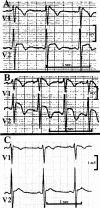Prevalence of the Brugada sign in idiopathic ventricular fibrillation and healthy controls
- PMID: 10862583
- PMCID: PMC1729399
- DOI: 10.1136/heart.84.1.31
Prevalence of the Brugada sign in idiopathic ventricular fibrillation and healthy controls
Abstract
Objective: To determine the prevalence of the Brugada sign (right bundle branch block with ST elevation in V1-V3) in idiopathic ventricular fibrillation and in an age matched healthy population.
Design: ECGs from 39 consecutive patients with idiopathic ventricular fibrillation and 592 healthy controls were reviewed. They were classified as definite, questionable, and no Brugada sign (according to predetermined criteria) by four investigators blinded to the subjects' status.
Results: Eight patients (21%) with idiopathic ventricular fibrillation but none of the 592 controls had a definite Brugada sign (p < 0.005). Thus the estimated 95% confidence limits for the prevalence of a definite Brugada sign among healthy controls was less than 0.5%. A questionable Brugada sign was seen in two patients with idiopathic ventricular fibrillation (5%) but also in five controls (1%) (p < 0.05). Normal ECGs were found following resuscitation and during long term follow up in 31 patients with idiopathic ventricular fibrillation (79%). Patients with idiopathic ventricular fibrillation and a normal ECG and those with the Brugada syndrome were of similar age and had similar spontaneous and inducible arrhythmias. However, the two groups differed in terms of sex, family history, and the incidence of sleep related ventricular fibrillation.
Conclusions: A definite Brugada sign is a specific marker of arrhythmic risk. However, less than obvious ECG abnormalities have little diagnostic value, as a "questionable" Brugada sign was observed in 1% of healthy controls. In this series of consecutive patients with idiopathic ventricular fibrillation, most had normal ECGs.
Figures



Comment in
-
Brugada syndrome: an electrocardiographic diagnosis not to be missed.Heart. 2000 Jul;84(1):1-2. doi: 10.1136/heart.84.1.1. Heart. 2000. PMID: 10862570 Free PMC article. No abstract available.
References
MeSH terms
LinkOut - more resources
Full Text Sources
